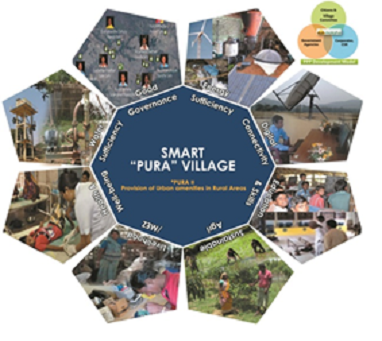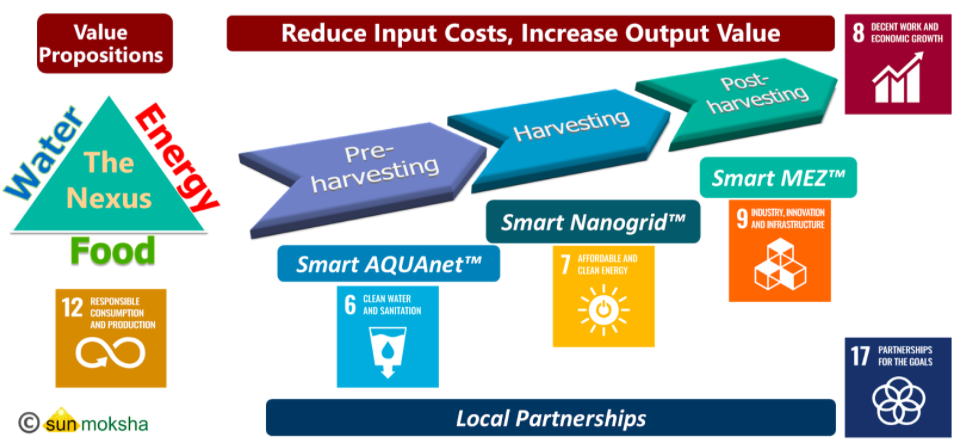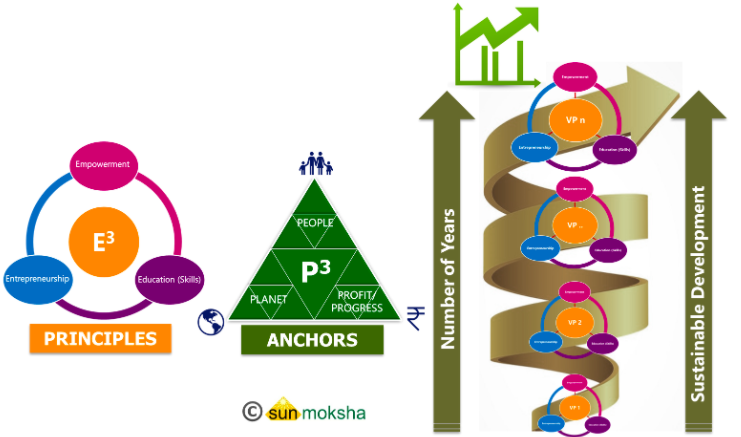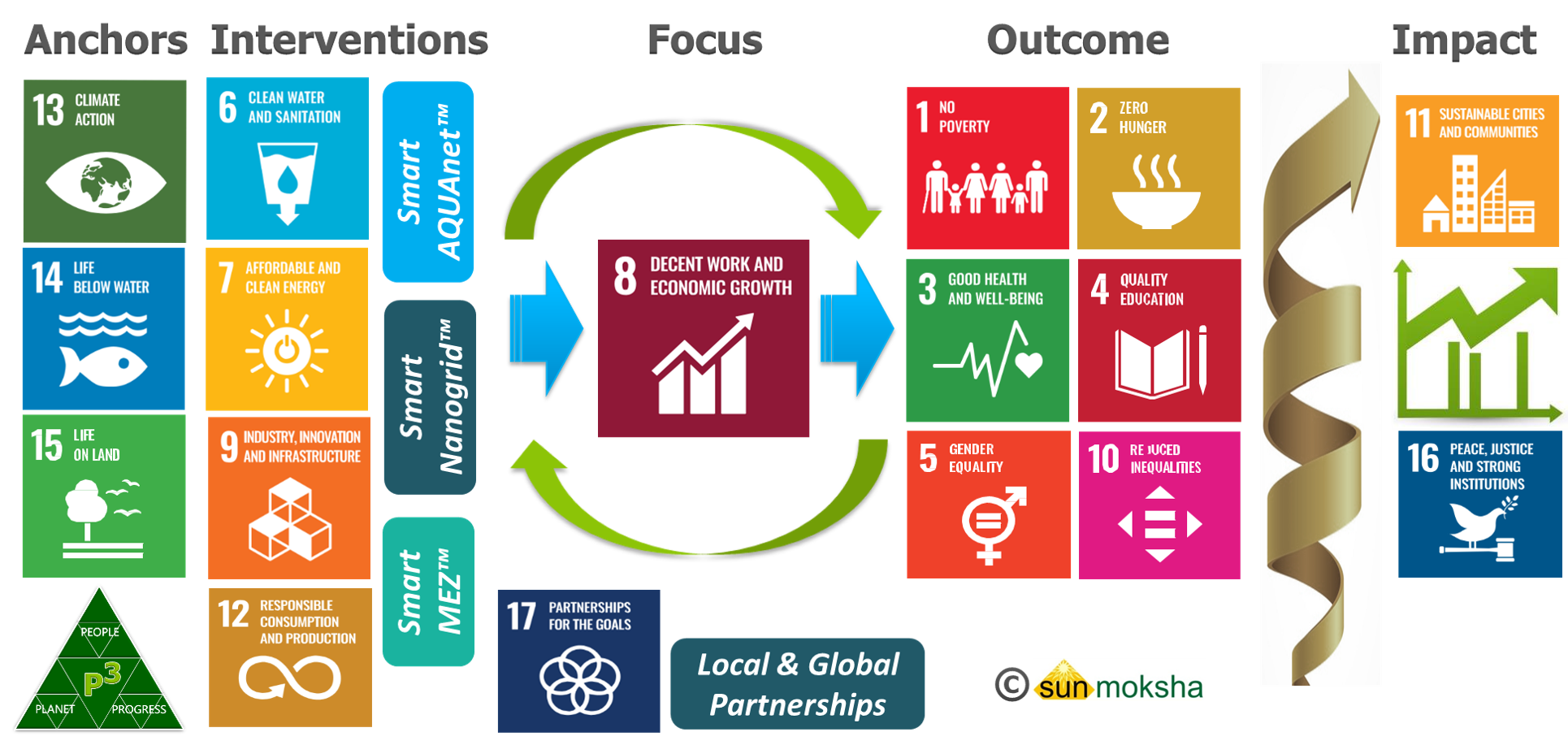Smart Village: Sustainable Socioeconomic Development of Villages
SunMoksha’s smart village builds around the vision of “PURA” (Provisioning Urban amenities for Rural Areas), a comprehensive model proposed by Late Dr. APJ Kalam. The model addresses the elements of PURA through various hard interventions, such as sustainable smart agriculture, water sufficiency, rural industry, locally relevant livelihood, energy sufficiency, waste management, health services, education & skill development, e-Governance, and improved digital connectivity. Additionally, soft interventions, such as good governance, sanitation, civic services, along with climate change adaptation are also considered. SunMoksha Smart Village moves the villagers up the value chain to improve the socio-economic status of its citizens leading to the attainment of Mahatma Gandhi’s ‘Gram Swaraj’, at the same time, maintaining a balance amongst people, planet and progress. Creation of livelihood and enterprise activities through sustainable resources, in turn, reduces the pressure on agriculture and land, and leads to triple-bottom-line impact, as well as, prevents migration of youth from rural to urban areas

SunMoksha’s Approach for Sustainable Rural Development
SunMoksha’s rural focus is on improving the quality of life of people at the bottom of the socioeconomic pyramid (BOP). Its strategy to address this goal is anchored in the creation of economic opportunities for the people, that fosters the improvement in their quality of life. It develops value propositions (sustainable smart solutions), to provide decent work and economic growth within the target community. SDG8 (Decent Work and Economic Growth) is adopted as the primary goal for SunMoksha’s value propositions (Figure 1). Once people gain economic strength, they can take care of their basic needs such as food, water, education, health, etc.

Figure 1: SunMoksha’s Development Strategy anchored in SDG-8
The outcome of SDG8 directly affects SDG1 and SDG2. Poverty is one of the main reasons for poor health and education. SDG3 and SDG4 are achieved in succession, once people have achieved a minimum level of economic strength. SunMoksha provides economic opportunities for the community at large, and thus, reduces inequities (SDG10). Attention is paid to ensure reduction of the gender gap (SDG5) by creating opportunities for women empowerment. The outcomes eventually lead, over the years, even generations, to development of sustainable communities (SDG11) and brings peace and justice in the society (SDG16).
Catalyzing Rural Economy: The Food-Water-Energy Nexus
India’s rural economy revolves around agriculture. However, this often does not provide enough income to farmers at the BOP. Significant effort is required to move the farmers up the value chain from farm to fork, or, pre- to post-harvesting, to bring about economic growth (SDG8), as shown in Figure 2. Agricultural economy, in turn, revolves around the nexus of food, water, and energy. SunMoksha has developed smart solutions in energy and water to increase food production with reduced input costs, and add value to the produce to increase the income of the farmers. It enables sustainable food production by aiding the entire value chain from pre- to post-harvesting.

Figure 2: The FEW Nexus: SunMoksha Solutions Move the Farmers up the Value Chain.
SunMoksha’s technology solutions, Smart AQUAnet™, Smart Nanogrid™ and Smart Micro-Economic Zone (Smart MEZ™) revolve around agriculture and livelihood, to reduce input costs and increase output value, and move the farmers up the value chain (Figure 2). These solutions are respectively anchored in SDGs 6, 7 and 9, to support sustainable socio-economic growth anchored in SDG12. SunMoksha develops partnerships (SDG17) with the local organizations and stakeholder, and engages with the local community and civic bodies to ensure long-term impact for the community.
SunMoksha’s Pathway to attaining Gram Swaraj
SunMoksha’s overarching goal is to develop Smart Villages based on “PURA”, Provisioning Urban amenities for Rural Areas, a model proposed by Late Dr. APJ Kalam. A Smart PURA Village moves the villagers up the value chain to improve the socio-economic status of its citizens leading to ‘Gram Swaraj’ (‘Village Self-Governance’, or ‘Sustainable Communities’) conceptualized by Mahatma Gandhi. SunMoksha’s interventions and smart solutions change as the community moves up the value chain, and eventually evolves into a sustainable community, or, Gram Swaraj (Figure 3). The development is achieved over several years, or even over a few generations.

Figure 3: Systematic Development of Sustainable Smart PURA Village to attain Gram Swaraj
SunMoksha’s Development Principles and Theory of Change
SunMoksha’s development strategy is anchored in three principles (E3) – Entrepreneurship (employment), Education (skills) and Empowerment (of individuals and communities), with available local resources as inputs (Figure 4). Education includes skills and knowledge necessary for the people to take care of their needs. SunMoksha’s Value Propositions, or sustainable smart solutions, create opportunities for employment and entrepreneurship for the community and empower them to move up the value chain. The solutions are developed to take into account the three drivers of sustainable development (P3), namely, environment (planet), economics (profit/progress) and society (people). SunMoksha develops & deploys solutions that are climate-friendly to conserve the resources of the planet. It earns profits for its growth and to serve the community sustainably. It creates an ecosystem of interventions that empower the communities to move forward on the development path.

Figure 4: SunMoksha’s Principle anchored in the Sustainability Triangle.
SunMoksha’s development model is a multistage process as shown in Figure 5. It begins with identifying value propositions or interventions through smart technologies and assets that provide access to essential services and create livelihood opportunities. These value propositions are anchored in the E3-P3 construct. The creation of livelihood and enterprise activities through sustainable resources, in turn, creates an ecosystem for development for improved quality of life. The interventions and smart solutions change as the community moves up the value chain, in a spiral of development. The development takes place over several years, or even over a few generations. At some stage the community becomes sustainable as in Gram Swaraj.

Figure 5: SunMoksha’s principles, focus, outcome and impact anchored in SDGs
SunMoksha’s overall principles, focus, value propositions (or interventions), outcome and impact as anchored in SDGs, are presented in Figure 6. The cycle between value proposition and outcome repeats as the community moves up the value chain in a systematic and organized manner, eventually leading to development of sustainable communities.

Figure 6: SunMoksha’s principles, focus, outcome and impact anchored in SDGs

